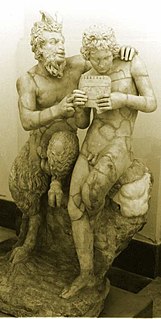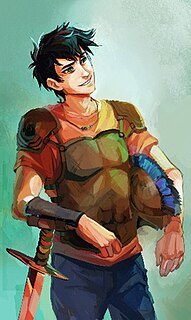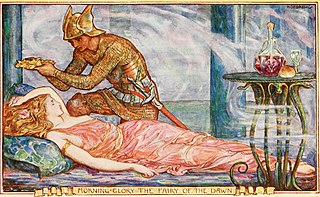
In Greek mythology, a satyr, also known as a silenus or silenos, is a male nature spirit with ears and a tail resembling those of a horse, as well as a permanent, exaggerated erection. Early artistic representations sometimes include horse-like legs, but, by the sixth century BC, they were more often represented with human legs. Comically hideous, they have mane-like hair, bestial faces, and snub noses and are always shown naked. Satyrs were characterized by their ribaldry and were known as lovers of wine, music, dancing, and women. They were companions of the god Dionysus and were believed to inhabit remote locales, such as woodlands, mountains, and pastures. They often attempted to seduce or rape nymphs and mortal women alike, usually with little success. They are sometimes shown masturbating or engaging in bestiality.

In ancient Greek religion and mythology, Pan is the god of the wild, shepherds and flocks, rustic music and impromptus, and companion of the nymphs. He has the hindquarters, legs, and horns of a goat, in the same manner as a faun or satyr. With his homeland in rustic Arcadia, he is also recognized as the god of fields, groves, wooded glens and often affiliated with sex; because of this, Pan is connected to fertility and the season of spring. The word panic ultimately derives from the god's name.

The faun is a half-human and half-goat mythological creature appearing in Greek and Roman mythology.

The historical mystery or historical whodunit is a subgenre of two literary genres, historical fiction and mystery fiction. These works are set in a time period considered historical from the author's perspective, and the central plot involves the solving of a mystery or crime. Though works combining these genres have existed since at least the early 20th century, many credit Ellis Peters's Cadfael Chronicles (1977–1994) for popularizing what would become known as the historical mystery. The increasing popularity and prevalence of this type of fiction in subsequent decades has spawned a distinct subgenre recognized by the publishing industry and libraries. Publishers Weekly noted in 2010 of the genre, "The past decade has seen an explosion in both quantity and quality. Never before have so many historical mysteries been published, by so many gifted writers, and covering such a wide range of times and places." Editor Keith Kahla concurs, "From a small group of writers with a very specialized audience, the historical mystery has become a critically acclaimed, award-winning genre with a toehold on the New York Times bestseller list."
Genre fiction, also known as popular fiction, is a term used in the book-trade for fictional works written with the intent of fitting into a specific literary genre, in order to appeal to readers and fans already familiar with that genre.
The World of Tiers is a series of science fiction novels by American writer Philip José Farmer. They are set within a series of artificially-constructed universes, created and ruled by decadent beings who are genetically identical to humans, but regard themselves as superior, who are the inheritors of an advanced technology they no longer understand. This technology enables the "Lords" to create novel lifeforms, and also to prevent aging or disease, making them effectively immortal. Their technology also allows them to create small artificial universes, and the planets and stars within them, and modify the physical laws to create unusual or interesting phenomena within these universes. Instantaneous travel within and between these universes is achieved by the use of "gates" which seem to function as teleportation devices, or as a means of creating wormholes between different regions of spacetime.

Fantasy literature is literature set in an imaginary universe, often but not always without any locations, events, or people from the real world. Magic, the supernatural and magical creatures are common in many of these imaginary worlds. Fantasy literature may be directed at both children and adults.

A magic ring is a fictional piece of jewelry, usually a finger ring, that is purported to have supernatural properties or powers. It appears frequently in fantasy and fairy tales. Magic rings are found in the folklore of every country where rings are worn. Some magic rings can endow the wearer with a variety of abilities including invisibility and immortality. Others can grant wishes or spells such as neverending love and happiness. Sometimes, magic rings can be cursed, as in the mythical ring that was recovered by Sigurd from the hoard of the dragon Fafnir in Norse mythology or the fictional ring that features in The Lord of the Rings. More often, however, they are featured as forces for good, or as a neutral tool whose value is dependent upon the wearer.

The Villa of the Mysteries is a well-preserved suburban ancient Roman villa on the outskirts of Pompeii, southern Italy. It is famous for the series of exquisite frescos in one room, which are usually thought to show the initiation of a young woman into a Greco-Roman mystery cult. These are now among the best known of the relatively rare survivals of Ancient Roman painting from the 1st century BC.

The Titan's Curse is an American fantasy-adventure novel based on Greek mythology written by Rick Riordan. It was released on May 1, 2007, and is the third novel in the Percy Jackson & the Olympians series and the sequel to The Sea of Monsters. It is about the adventures of the 14-year-old demigod Percy Jackson as he and his friends go on a dangerous quest to rescue his 14-year-old demigod friend Annabeth Chase and the Greek goddess Artemis, who have both been kidnapped by the titans.
Lynn Kurland is a best-selling American author of historical, time travel, and fantasy romance novels. The characters in most of her books all belong to one of three extended families and her love scenes are not as explicit as many other popular romances. She is a recipient of the RITA Award.

The Resting Satyr or Leaning Satyr, also known as the Satyr anapauomenos is a statue type generally attributed to the ancient Greek sculptor Praxiteles. Some 115 examples of the type are known, of which the best known is in the Capitoline Museums.

Perseus "Percy" Jackson is a fictional character, the title character and narrator of Rick Riordan's Percy Jackson & the Olympians series. He is also one of seven main protagonists of the sequel series The Heroes of Olympus, appearing in every book except The Lost Hero, and appears in the Trials of Apollo series, making him one of the few characters to appear in all three series of the Camp Half-Blood chronicles. He has also been a narrator and protagonist in Riordan's Greco-Roman/Egyptian crossover stories, part of the Demigods and Magicians collection. The character serves as the narrator in Percy Jackson's Greek Gods and Percy Jackson's Greek Heroes, also by Rick Riordan.

Fantasy is a genre of speculative fiction involving magical elements, typically set in a fictional universe and sometimes inspired by mythology and folklore. Its roots are in oral traditions, which then became fantasy literature and drama. From the twentieth century, it has expanded further into various media, including film, television, graphic novels, manga, animations and video games.

The Lost Hero is an American fantasy-adventure novel written by Rick Riordan, based on Greek and Roman mythology. It was published on October 12, 2010, and is the first book in The Heroes of Olympus series, a sequel to the Percy Jackson & the Olympians series. It is preceded by The Last Olympian of Percy Jackson & the Olympians and followed by The Son of Neptune. The novel has since been translated into many languages and released as a hardcover, e-book, audiobook and paperback.

The Heroes of Olympus is a pentalogy of fantasy-adventure novels written by American author Rick Riordan. The novels detail a conflict between Greek demigods, Roman demigods, and Gaea also known as Mother Earth. In the fourth book of the series, there is also a semi-large fight against Tartarus, which, in Greek mythology, was the darkest and deepest point of the underworld. The series can be read as a standalone volume, but is meant to be read after Percy Jackson and the Olympians. The series that takes place after the Heroes of Olympus timeline is The Trials Of Apollo. Riordan introduces Roman mythology in his sequel series as well as several new characters. The first book of the series, The Lost Hero, was published on October 12, 2010. The final entry in the series, The Blood of Olympus, was published on October 7, 2014.
Kathryne Kennedy is an American paranormal romance and historical fiction writer.

Darkfever is the first novel in the Fever series written by #1 New York Times best-selling American author Karen Marie Moning. The book was published in November 2006 by Delacorte Press. The romantic fantasy novel tells the story of the main characters journey into the supernatural world of fairies after she travels across the world to find her sister's murderer. The story is set in Dublin, Ireland and involves Celtic mythology.













